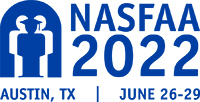How to Survive a Financial Aid Audit/Focus on COVID-19 Issues
By Megan Walter, NASFAA Policy & Federal Relations Staff
Moderator:
Samantha Veeder, Associate Dean for College Enrollment and Director of Financial Aid at the University of Rochester
Speakers:
Leslie Howard, Vice President of Financial Aid Compliance at Berkeley College
Gregory Rinderle, Director, McClintock & Associates, P.C.
Starting off the Monday morning sessions, Leslie Howard, vice president of financial aid compliance at Berkeley College, and Gregory Rinderle, director at McClintock & Associates, reviewed common concerns and best practices when preparing for an audit. They focused on issues that have arisen in financial aid offices due to COVID-19, such as the Higher Education Emergency Relief Fund (HEERF) and different waivers we saw introduced during the pandemic.
Rinderle started the presentation covering the two different types of audit guides: the single audit A-133 guide and the audit guide for proprietary institutions. Generally, the audit for proprietary schools contains two reports, one based on the financial statements and one based on compliance, and are completed annually. Single audits contain only one report and are completed annually, biennially, or triennially, depending on the institution,
The HEERF audits are also different depending on the type of school. The single audit, the audit for non-profit institutions, has certain compliance requirements that are required to be audited, such as activities allowed, cash management, eligibility, and reporting. The auditor must determine which of the compliance requirements are likely to have direct and material effect on the federal program. The HEERF audit is due nine months after the year end as part of the Single Audit, if they had more than $750,000 in total federal funding. Proprietary institutions have a threshold of $500,000 in HEERF funding to trigger an audit, which is due six months after year end with a financial statement and Federal Student Aid (FSA) compliance audit.
Howard reiterated the importance of having your timelines available and accurate to prepare for your HEERF audit. He mentioned that there have been several and constant changes in guidance around the HEERF funds and it is financial aid administrators' responsibility to be aware of them. Howard covered some of the topics that auditors would be looking for, specifically, how funds were used in relation to the regulations that guided them, reporting on the website and annually and quarterly to the Department of Education, use of professional judgment, Satisfactory Academic Progress (SAP) relief, return of Title IV funds (R2T4) relief, approved leave of absence, and the campus-based waivers.
To round out the session, the duo covered what schools can do to prepare for their audit, including performing self-audits, especially around times when changes were made to policy, ensuring staff is properly trained, and reviewing their office’s policies and procedures manual to ensure staff is following procedures correctly.
They also alerted institutions that during their audit, they can expect a review of all of their institutional internal documents, interviews of staff members, reviews of key institutional elements like program eligibility, institutional eligibility, and consumer information, and reviews of key student eligibility elements, like dependency overrides, cost of attendance, and verification. The audit can also look into files outside of the financial aid office, looking into student files in admissions or bursar offices.
When your audit is complete, institutions should be ready to submit all outstanding documents and/or corrective action pieces in a quick and timely manner and to follow up with your auditor with any questions or concerns so you are prepared for and future audits.
Publication Date: 6/27/2022

You must be logged in to comment on this page.